|
Sarcophytonehrenbergi are able acquire nutrients by capturing food using their tentacles as well as from symbiotic algae that live within them called zooxanthellae, and due to this dual nutrient acquiring system they are able to survival in a poor nutrient environment (Fabricius & Alderslade, 2001). There are two modes of nutrition uptake in the leather coral.
Photosynthesis
During the day or when sunlight is available, the polyps of the colony will extend and photosynthesize, which can increase approximately 30% of nutrition input (Fabricius & Klumpp, 1995). From studied species, polyps that were removed and looked under a microscope, zooxanthellae were found all along the stalk of the polyp, except for the tips where the tentacles are located (pic 1).
A sagittal sectioning of the polyp revealed that the zooxanthellae were located at the gastro dermis of the polyp. There were also some accumulations at the top, probably due to most exposed to the sun (pic 2). Through observation, during the day when disturbance were low, extension of polyps are visible (pic 3), however tentacles are not fully extended (pic 5).
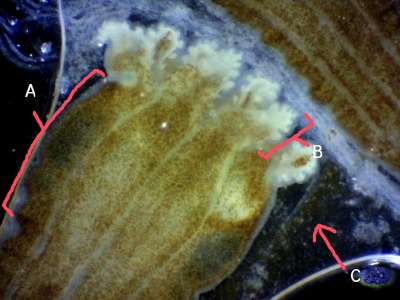 |
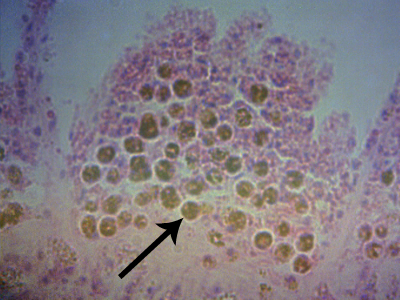 |
Pic 1 A single polyp removed from the anthostele.
Zooxanthellae are visible on the anthocodia, but
not on the tentacles.
A: Anthocodia; B: Tentacles; C: Mucus |
Pic 2 Sagittal sectioning of a stained polyp tip.
Arrow points to a single zooxanthellae. |
Suspension feeding
Leather corals are able to suspension feed by capturing particles from the water column. They are able to extend their polyps, and using their tentacles to capture particles such as zooplankton, phytoplankton, marine snow, and fish feces (Sprung, 1999). Nematocysts on octocorals are relatively simple compared to Cnidarians, Hydrozoans, and Hexacorallia, thus comparatively ineffective (Fabricius &Alderslade, 2001). Aside from capturing nutrients, dissolved organic nutrients are able to be absorbed through the epidermis due to the heavily covered microvilli (Schlichter, 1982). For suspension feeding to be successful, water flow is important, polyps flow with the current, and occasionally pulsate to collect nutrients from the water column as well as generate more currents for mixing (Kremien et al., 2013) (video 1). Observation of the studied specimen during the night showed extension of polyps (pic 4) as well as the extension of tentacles (pic 6).
Video 1: Polyps flowing (Select 1080p HD for best quality viewing)
Day
|
Night
|
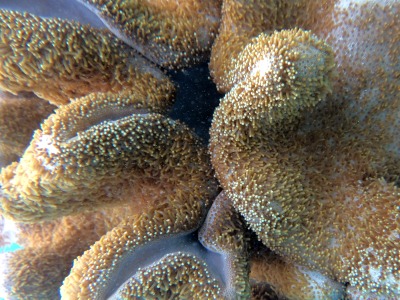 |
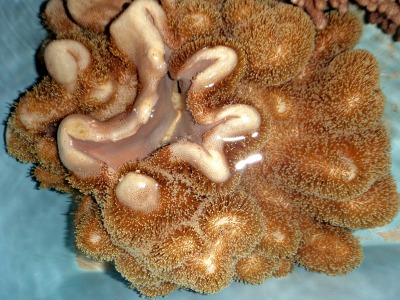 |
Pic 3 Leather coral during the mid day; polyps are
not fully extended. |
Pic 4 Leather coral during the night; polyps are
fully extended.
(Picture has been taken with flash) |
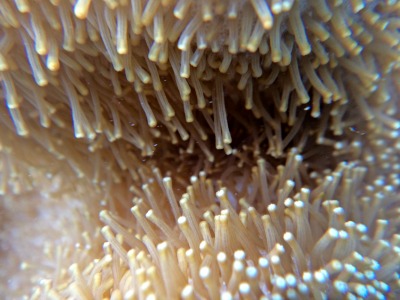 |
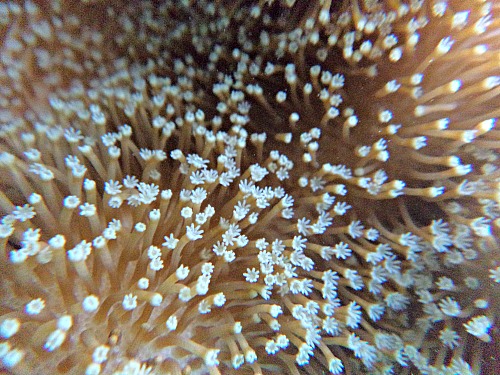 |
Pic 5 Close-up of polyps during the day. Although
some polyps may be extended, tentacles are
retracted into the polyp. |
Pic 6 Close-up of the polyps during the night.
Polyps and tentacles are both fully extended.
Tentacles flow with the water current. |
|